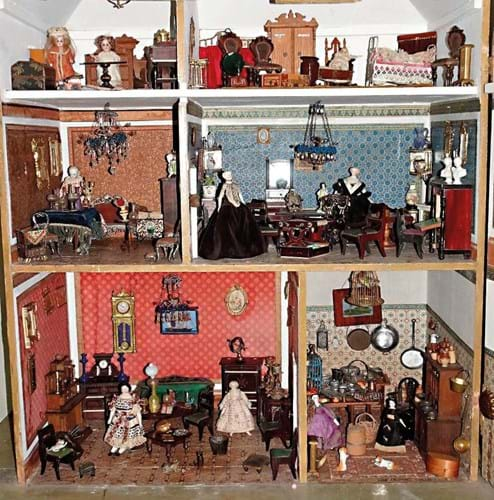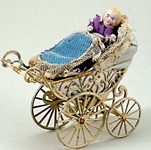Germany was a powerhouse of toy manufacture in the 19th century – and the Erzgebirge (Ore Mountains) region played a major part. When mining began to decline, the locals looked for other work and the abundance of timber meant the production of wooden playthings became an extra source of income.
From 1873, Moritz Gottschalk, owner of a bookbinding shop in the small town of Marienberg, began to produce dolls’ houses and other toys. He would later export his wares to England, France, the Netherlands, Scandinavia and America.
One of Gottschalk’s creations ended up in a Kent auction on November 4, selling for a hefty £17,000. The estimate at C&T (20% buyer’s premium) in Kenardington had been £2000-3000.
The Gottschalk model 2248 dolls’ house with original contents, c.1893-94, featured a paper brick effect exterior, blue roof and a green base with front garden and fencing.
The front opened to six rooms on three levels with details ranging from a Rock and Graner tinplate oval table and Waltershausen settee in the sitting room to a bird cage containing a wax parrot in the kitchen.
Illustrated in The Encyclopedia of Toys by Constance Eileen King, the house measured 3ft 3in tall x 3ft 2in wide (99 x 96cm).
The vendor was a deceased ‘titled lady’ who had been collecting dolls and dolls’ houses from the 1960s and probably purchased this house at that time, said C&T toy and doll specialist Leigh Gotch. He added: “The buyer was a European collector. There were a good number of bidders for the house up to about £6000 then it came down to two European collectors.
'The complete package'
“Gottschalk were a very good dolls’ house and dolls’ house furniture manufacturer, producing good-quality pieces from the early 1890s through to the early 1930s. This house was one of the larger types made and dates to 1893-94. The other great appeal was that it contained a great array of period furniture, dolls and ornaments. So, all in all, it was the complete package.”
















